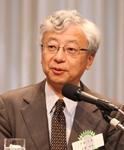Trends in the Japanese Economy
November 27, 2013
Mr. Motoshige Itoh
President, National Institute for
Research Advancement
Graduate School of Economics,
Faculty of Economics,
The University of Tokyo
�� The long history of economics records some major turning points, such as the oil crisis, the Plaza accord, the economic bubble burst and the collapse of Lehman Brothers. The Japanese economy today is definitely entering such a turning point.
The long history of economics records some major turning points, such as the oil crisis, the Plaza accord, the economic bubble burst and the collapse of Lehman Brothers. The Japanese economy today is definitely entering such a turning point.
��The economic policies advocated by Prime Minister Abe, the Abenomics, try to respond to the drastic and ever-faster changes in the economy and society as a whole. As we all know, Japan undergoes major demographic changes due to aging society with falling birth rate. Rapid economic growth in our neighboring Asian countries gives a dramatic impact on our foreign and domestic markets. Technologies advance drastically in various fields, including the information and communications technology. I must say Japan had failed to make rapid responses to these foreseeable changes, which led to the ��Lost Two Decades�� in our country.
��Now, what impeded Japan from making rapid changes? The shortest answer is ��deflation�� that has discouraged spending and investment by households and companies and swelled their financial assets. Many business managers I had spoken to stated that ��in deflation, we should not take action just to be on the safe side.�� The government is urged to take immediate measures to redress this negative attitude and stimulate the economy.
��The ��three arrows�� of Abenomics are expected to revive our economy. Thanks to the ��first arrow�� of aggressive monetary easing policy, stock prices have risen sharply to exceed 13,000 yen and entailed other positive economic results. The real estate market is booming in Tokyo, which is further activating transactions in the local market. Economic growth rate has jumped from the low average of 0.5-0.7% during the past decade to 4.1% (first-quarter of 2013) and 3.8% (second-quarter). We are to advance into the next stage, with some positive results of monetary and fiscal policy.
��Not a few people seem to misunderstand the ��third arrow�� of Abenomics, including foreign investors. They think the third arrow is all about growth strategy that aims to bolster the ��supply side�� economy by enhancing competitiveness, resource allocation and innovation of companies through deregulation, market opening and tax reform. Such measures take considerable time to make positive effects on the Japanese economy. This is why I want to highlight the importance of stimulating investments from the ��demand side.��
��About six months ago, I attended a conference in France to discuss the economic crisis in Europe, including Spain, Italy, Portugal and Greece that suffer from massive national debt. The situation is worse in Spain where a real estate bubble had burst that led to collapse in its stock prices, while companies suffer from excessive loan and excessive production capacity, and financial institutions struggle with non-performing loans. The picture looks quite similar to what Japan experienced a decade ago. An economist from Europe asked me about the situation in Japan, to which I answered ��as the saying goes, ��fellow sufferers pity each other,�� we also have the problem of massive public debt. But let me add that our private sector looks flourishing.�� In fact, the ratio of household financial assets to disposable income is the highest in Japan that exceeds 4 times.
��Half of the listed companies in Japan are said to be debt-free. The problem here is that companies are risk-averse and hesitate to commit their funds to investments. They prefer to accumulate internal reserves. Companies have become cautious about venturing on investments in a prolonged deflationary economy. Business leaders, who have taken safety measures of staying inactive in time of deflation, must now be alerted to the danger of staying inactive after overcoming deflation.
��Companies are urged to boost their investment to accelerate various policies formulated by the government. Let me take an example of the Electricity System Reform bill that outlines various measures to be implemented, such as reinforcing a cross-regional electricity supply system, full retail choice and full liberalization of power generation that responds more flexibly to diversified needs. Accidents at the Fukushima nuclear power plants call for extensive discussions on the future of nuclear energy in Japan and how to enhance utilization of thermal power generation. These initiatives could lead to growth strategy that stimulates private investment. For example, rebuilding thermal power plants will expand investment opportunities of various industries, including iron and steel, energy, papermaker, chemical and trading firms.
��It goes without saying that the 2020 Olympics and Paralympics in Tokyo is another promising event that will stimulate private investment. I personally believe to join the TPP (Trans-Pacific Strategic Economic Partnership Agreement) negotiations is essential to activate the Japanese economy through trade liberalization, globalization and utilization of the vitality in Asia.
��I meant to talk on how to achieve fiscal soundness, but I��m running out of time. Let me close my speech by reiterating growth of the Japanese economy lies in the expansion of ��demand side�� investment.